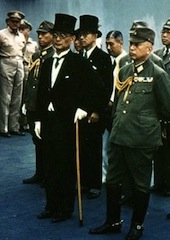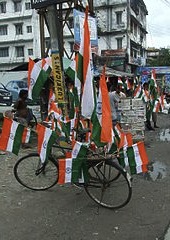East Asia: Leaving Postwar Angst Behind
Can East Asia move past 19th century-style territorial disputes over small islands?
August 15, 2013

It is never easy to let go of the past. Across Asia, the legacy of World War II is particularly painful.
While its end ultimately fueled phenomenal growth, the destruction and suffering it caused can and should never be forgotten.
Case in point: As Japan marks the 68th anniversary of its defeat on August 15th, and as much of the rest of Asia remembers their countries’ struggles under Japanese occupation, too much emphasis has been placed on remembering the pain.
Important as it is to come to terms with history, focusing too much on it has clear downsides. It can not only hurt the security prospects for Japan, South Korea and China, but it may also put a brake on what all three value so highly: economic growth.
An unhealthy focus on varying interpretations of history has taken center stage in diplomatic relations between three of Asia’s most influential powers.
Japan, for instance, has certainly not shied away from glorifying its past as politicians continue to visit the controversial Yasukuni shrine, despite knowing full well how their actions may be received by China, South Korea, and Taiwan.
Firing up controversy seems to have become a sign of strength in the region as politicians look to history for answers.
At the center of the opposing views about the past among the three nations are a handful of islets in the East China Sea.
While the territorial dispute is ostensibly about access to natural resources, it has effectively come to symbolize the conflict of national identities.
The conflict over the Senkaku islands, as the Japanese call it — Diaoyu in Chinese — in particular continue to escalate in what a senior Japanese defense ministry official calls “an alarmingly fast and unexpected rate.”
For now, there seems to be no easy resolution in sight. Meanwhile, tensions between South Korea and Japan over the Dokdo, or Takeshima, islands too show no signs of abating.
Neither side is willing to back down on its claims, citing various treaties and other documents as proof of their rightful ownership.
Yet, it would be folly to continue looking back to history for an answer. The real solution to the Senkaku/Diaoyu dispute should be joint development of islets to tap into the potential resource wealth.
One possibility may be to declare the islets to be neutral territory requiring joint stewardship by China and Japan as well as Taiwan.
With all three parties working closely together to develop natural resources and share fishing rights, joint development of the territories would exemplify the future of successful international cooperation.
The same basic idea also very much applies to Japan’s future relations with Russia. True, the two countries have yet to finish an official peace treaty to end a war nearly seven decades ago.
But driven by economic interests, the Japanese and Russians are increasingly willing to work together to reach some sort of compromise over the Kuril Islands off of Siberia, known in Japan as the Northern Territories.
For Japan, a resolution means being able to tap into Russia’s vast energy supply.
For Russia, which — like the United States — is rebalancing its focus toward Asia, it means being able to attract Japanese investments to Siberia.
A delegation of about 120 Japanese business leaders, led by none other than Prime Minister Shinzo Abe, was warmly received by President Vladimir Putin in Moscow in April. This suggests the willingness of both sides to lay aside their ideological differences for practical purposes.
It is ironic that, while Japan and Russia become more willing to work together to reach a compromise over the territorial legacy of World War II, that same historical event is driving an ever-deeper wedge between Japan, China and South Korea.
This is all the curious since this is a time when the three countries have more common economic interests than ever before. For South Korea and Japan in particular, worries about the global energy market should be uniting the two countries.
Both South Korea and Japan face the challenge of questioning the safety of nuclear energy on the one hand, while remaining heavily dependent for oil from some of the world’s most politically unstable countries.
They would be far better off by joining forces and working together to develop new technologies that use alternative energy sources that are more energy efficient.
Both South Korea and Japan could benefit too from greater bilateral cooperation to diversify their energy supplies offshore.
The list of economic risks uniquely facing East Asia is long.
The most prominent ones are a shrinking population, an aging society, ballooning public spending needs, making better use of women in the workforce and a dilemma about opening its doors to immigration.
There also is the issue of paving the way for longer-term economic expansion, given the limits of a manufacturing-based economy that has served the region so well during the post-war years to date.
Asia remains a bright spot in the global economy, in part due to the political stability of the region. Irrational nationalism should have no place in the future, and should be kept in the history books.
Takeaways
East Asia faces plenty of problems. Fights over uninhabited islands shouldn't be one.
Irrational nationalism has no place on East Asia's agenda. Economic pragmatism must be front and center.
Japan and S. Korea face the limits of a manufacturing economy that served the region so well to date.
Ironic that Japan and Russia are willing to work together to find compromise on the legacy of WWII.
The fallout from WWII is driving an ever-deeper wedge between Japan, China and South Korea.
Read previous

Celebrating India’s Independence
August 14, 2013
